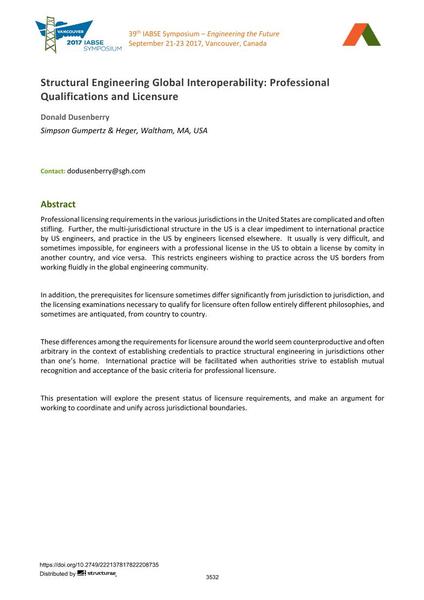Structural Engineering Global Interoperability: Professional Qualifications and Licensure

| Autor(en): |
Donald Dusenberry
(Simpson Gumpertz & Heger, Waltham, MA, USA)
|
|---|---|
| Medium: | Tagungsbeitrag |
| Sprache(n): | Englisch |
| Tagung: | IABSE Symposium: Engineering the Future, Vancouver, Canada, 21-23 September 2017 |
| Veröffentlicht in: | IABSE Symposium Vancouver 2017 |
| Seite(n): | 3532 |
| Jahr: | 2017 |
| DOI: | 10.2749/222137817822208735 |
| Abstrakt: |
Professional licensing requirements in the various jurisdictions in the United States are complicated and often stifling. Further, the multi-jurisdictional structure in the US is a clear impediment to international practice by US engineers, and practice in the US by engineers licensed elsewhere. It usually is very difficult, and sometimes impossible, for engineers with a professional license in the US to obtain a license by comity in another country, and vice versa. This restricts engineers wishing to practice across the US borders from working fluidly in the global engineering community. In addition, the prerequisites for licensure sometimes differ significantly from jurisdiction to jurisdiction, and the licensing examinations necessary to qualify for licensure often follow entirely different philosophies, and sometimes are antiquated, from country to country. These differences among the requirements for licensure around the world seem counterproductive and often arbitrary in the context of establishing credentials to practice structural engineering in jurisdictions other than one’s home. International practice will be facilitated when authorities strive to establish mutual recognition and acceptance of the basic criteria for professional licensure. This presentation will explore the present status of licensure requirements, and make an argument for working to coordinate and unify across jurisdictional boundaries. |
0.18 MB
- Über diese
Datenseite - Reference-ID
10292907 - Veröffentlicht am:
02.02.2019 - Geändert am:
21.05.2021



